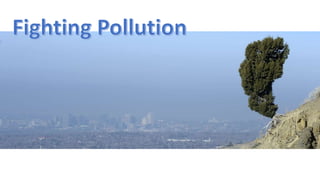
Classifying Waste into Biodegradable and Non-Biodegradable
- 2. Look around in your house. You will find household waste such as fruit and vegetable peelings, paper, plastic cans, plastic bottles, etc. some of this waste can break down into useful nutrients but some cannot.
- 3. biogradable waste non-biogradable waste Waste can be classified as biodegradable and non- biodegradable on whether or not it can break down. Let’s find out about both types.
- 4. Biodegradable materials: Things that can be easily decomposed by natural agents like water, oxygen, ultraviolet rays of the Sun, microorganisms, etc. are called biodegradable.
- 5. For example, when a banana peel is thrown outside, several microorganisms act upon it. Natural elements such as oxygen, water and heat also aid in its decomposition and break it into smaller units. It finally returns back to the soil and nourishes it with nutrients and minerals.
- 6. Biodegradable substances include food waste like vegetable and fruit peels, dead plants and animals, eggshells, paper materials, garden waste, etc.
- 7. Non-biodegradable materials: Not every material is biodegradable. Materials which cannot be decomposed are known as non- biodegradable materials. They stay in the soil for a long time and do not rot easily.
- 8. This waste is produced by humans to fulfil their needs. Things made of metals, glass, plastic, ceramics, foam, etc. are examples of non- biodegradable materials.
- 9. Impact of non-biodegradable materials on the environment:
- 10. Non- biodegradable products when thrown away not only cause problems for plants, but for animals as well.
- 11. These materials, when not disposed of properly, pollute land and stay in the soil for a very long time, thus affecting the growth of plants. Being producers, plants start a food chain. So, non-biodegradable materials eventually affect a food chain.
- 12. Plastic bags add tons of carbon dioxide (CO2) to the air annually, which causes air pollution and a rise in temperature. These plastic materials cause death of marine species when eaten mistakenly by them. Birds and animals can also choke on plastic bags.
- 13. Toxic chemicals from these materials can leach into water bodies, which can poison water.
- 14. Ways to reduce the impact of non-biodegradable materials: Non-biodegradable materials cannot be banned completely because they are produced to meet human needs, but their effects on the environment can be controlled by taking the following steps:
- 15. By incineration Garbage is burned in a big furnace called an incinerator or waste incinerator. This method helps to reduce waste but the smoke coming out of an incinerator pollutes the air.
- 16. Waste incineration systems produce a wide variety of pollutants which are dangerous to human health. Far from eliminating the need for a landfill, waste incinerator systems produce toxic chemicals which have serious environmental health consequences.
- 17. People are exposed to toxic chemicals in several ways: Breathing toxic air affects different body systems, i.e. respiratory system, nervous system, etc.
- 18. Incinerators release toxic gases such as nitrogen dioxide (NO2) and sulphur dioxide (SO2) these gases mix with water vapour in the clouds and convert to toxic acids like nitric acid (HNO3) sulphuric acid (H2SO4) etc. and fall as acid rain, acid rain affects human, plant and animal life. Drinking water from a reservoir contaminated by air pollutants from an incinerator can have adverse effects on animal and human life.
- 19. These toxic chemicals can be removed by using a smoke scrubber. The term “scrubber” refers to a device which controls pollution. In this system, a liquid is used to remove unwanted pollutants from a gas stream.
- 20. By 4Rs strategy The ‘4Rs’ method is the most effective method to fight against the impact of waste materials on the environment. The 4Rs (Reduce, Reuse, Recycle and Rot) are organized in a hierarchy, or order of importance.
- 21. Reduce The first target is to reduce the amount of waste we generate. If we use less materials, we can reduce the amount of waste produced. Some ways to reduce waste include buying products with minimal packaging, using a cloth bag instead of a paper or plastic bag. When waste do0es occur, the next level in the hierarchy is to reuse items.
- 22. Reuse The reuse of items does not require the expense of energy or new materials because the process of manufacturing is not involved. Some ways to reuse items include using both sides of a sheet of paper, saving and using plastic or paper grocery bags for the future and donating unwanted items such as clothing books or toys to a charity.
- 23. Recycle If waste items cannot be reused, the next level is recycling. For example, paper can be recycled to produce new paper. Glass can be recycled to produce new bottles, etc. recycling conserves natural resources, reduces pollution and saves energy.
- 24. Rot Organic materials (originally living plants or animals) that cannot be reused or recycled can be decomposed (rot) to produce compost, a rich soil material that increases soil productiveness and helps plants grow.
